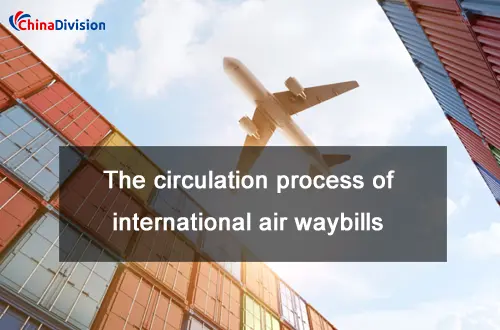What is the Circulation Process of International Air Waybills?
Air waybills (AWB) are the core documents throughout the entire transportation chain. They are not only the certificate of cargo handover, but also the proof of the transportation contract between the carrier and the consignor. It involves multiple entities such as consignors, airlines, and consignees. According to statistics, nearly 40% of international air transport delays and disputes are caused by unfamiliarity with the bill of lading process or operational errors. For B2B companies and cross-border e-commerce sellers, understanding the circulation process of bills of lading can not only optimize the supply chain, but also ensure the smooth delivery of goods.
Table of Contents
However, many companies are unfamiliar with the bill of lading circulation process or improper selection of bill of lading types, resulting in cargo delays, cost disputes, and even ownership disputes. This article will deeply analyze the circulation links of international air waybills and provide solutions from professional international fulfillment service providers to help you avoid risks and improve efficiency.
What is an air waybill?
An air waybill (AWB) is a transport contract certificate and cargo receipt issued by an airline or its agent after receiving the cargo. Unlike ocean bills of lading, air waybills have three characteristics:
Non-property certificate: cannot be transferred by endorsement, holding a bill of lading does not mean ownership of the goods
Non-circulation: the consignee does not need to show the original bill of lading when picking up the goods, only needs to prove his identity
Travel with the goods: at least one original (usually the green carrier copy) is always transported with the goods
The standard air waybill adopts an eight-copy design, of which three legally binding originals are distinguished by different colors: green (carrier copy), pink (consignee copy) and blue (shipper copy).

The whole process of international air waybill circulation
① Consignment link
The consignor hands over the goods to the airline or its agent and fills out the air waybill, including:
Information of consignor and consignee
Detailed description of the goods (quantity, weight, volume)
Mode of transportation and destination
After reviewing the consignment note, the airline issues an air waybill (AWB) as a certificate of receipt of the goods and proof of the transportation contract.
Key points:
Accuracy of information: If the name or weight does not match the actual value, it may lead to customs clearance delays or fines (such as the EU's maximum fine of €500,000 for false declaration of battery products).
Type of bill of lading selection: Choose the non-transferable Straight AWB (applicable to direct delivery) or the transferable Order AWB (applicable to intermediary transactions) according to the trade terms.
② Transportation link
The original air waybill accompanies the goods to ensure that the goods can be tracked during transportation. Airlines make transportation arrangements based on bill of lading information, including:
Cargo loading and unloading
Transit operations
Destination flight scheduling
Risk warning:
Loss of bill of lading: If the original bill of lading is lost during transportation, the shipper needs to apply for "bill of lading reissue", which may cause the goods to be detained for 7-15 days.
Transit delay: In multimodal transport, if the bill of lading is not marked "Transshipment Allowed", the destination port may refuse to pick up the goods.
③ Arrival at the destination port
After the goods arrive at the destination port, the airline or agent notifies the consignee to pick up the goods and enters the bill of lading information into the system for the consignee to query. Customs clearance may involve additional document review to ensure that the goods comply with import regulations.
④ Pick-up stage
The consignee shall go through the pick-up procedures with a valid identity certificate and arrival notice. After confirmation, sign and pick up the goods. The airline retains a copy of the bill of lading as a record of the delivery of the goods.
⑤ Settlement stage
In the case of freight payable on delivery, the consignee shall pay the freight. The airline or agent settles according to the bill of lading amount and provides invoices and settlement vouchers.
Pitfall avoidance guide:
Prepaid and cash on delivery options: It is recommended to use prepaid freight (PPD) for bulk goods to avoid the risk of consignee refusal to pay.
Invoice dispute: If the freight amount does not match the bill of lading, the original contract must be retained as the basis for arbitration.
A complete guide to bill of lading types: How to accurately match according to business needs?
① Classification based on whether it is transferable
Straight Bill of Lading: Non-transferable, the consignee is clearly specified on the bill of lading, and the goods can only be picked up by the designated consignee.
Order Bill of Lading: Transferable, transferable after endorsement (name endorsement or blank endorsement).
Charter Party Bill of Lading: Usually used for charter transportation, the bill of lading terms are determined according to the charter contract.
Switch Party Bill of Lading: Used to change the consignee of goods during transportation.
Air Waybill: Special for air transportation, usually non-transferable.
② Division of responsibility according to the carrier
Ocean Bill of Lading: Applicable to ocean transportation.
Inland Bill of Lading: Applicable to inland transportation.
Direct Bill of Lading: Goods go directly to the destination port without transit.
Multimodal or Combined Transport Bill of Lading: Applicable to multiple modes of transportation.
Through Bill of Lading: Applicable to intermodal transportation.
Transshipment Bill of Lading: Applicable to goods that need to be transited.
How to optimize international air waybill management?
① Use electronic air waybill (eAWB)
Reduce paper documents and improve processing efficiency.
Real-time data synchronization to ensure that goods can be tracked.
Comply with IATA standards and simplify customs clearance processes.
② Choose a reliable logistics partner
Professional customs clearance support to ensure compliance with international regulations and reduce customs clearance delays.
Smart order fulfillment, optimize bill of lading management, and improve supply chain efficiency.
③ Use intelligent logistics technology
Real-time tracking system to improve the visual management of goods.
Automated inventory management reduces human errors and improves fulfillment efficiency.
Common user problems and solutions
How to choose the right bill of lading type?
MAWB: Applicable to situations where the consignee arranges customs clearance after the goods arrive abroad, and the consignor has full trust in the consignee.
HAWB: Applicable to situations where the consignor needs to control the goods or the freight is paid on delivery.
How to ensure that the bill of lading information is accurate?
During the consignment process, the consignor needs to carefully check the consignment note information to ensure that the description of the goods, the consignee and consignor information, etc. are accurate.
During the transportation process, the airline needs to make transportation arrangements based on the bill of lading information to avoid delays caused by incorrect information.
How to deal with the loss or damage of the bill of lading?
If the bill of lading is lost or damaged, the consignor needs to notify the airline or its agent in a timely manner and provide relevant certificates and remedial measures as required by the airline.
Chinadivision - Your International Logistics Optimization Partner
As an international logistics fulfillment service provider, Chinadivision provides intelligent order fulfillment, global warehouse management, and real-time logistics tracking to help companies optimize their supply chains and improve customer satisfaction.
Chinadivision recommends that you choose the appropriate type of air waybill based on the specific needs and risk preferences of cargo transportation. At the same time, it is recommended that you cooperate with reliable airlines or freight forwarders to ensure the smooth and safe flow of bills of lading. If you encounter any problems in the flow of air waybills, please feel free to contact Chinadivision, an international fulfillment service provider. Our professional team will provide you with tailor-made solutions to help you successfully complete order fulfillment.





